Here we go again.
Another buzzword has taken the B2B industry by storm. To be fair, Revenue Operations has been in play for many years…it’s only been recently that organizations wanting real revenue growth are looking at this initiative differently.
In fact, 75% of the highest growth companies in the world will deploy a RevOps model by 2025. (Gartner, 2021)
So, let’s dig into what it is, what it isn’t, and how it evolves what you’re doing already. And be sure to read this blog on five ways RevOps can drive positive impact and grab this free charter that’ll help you get moving!
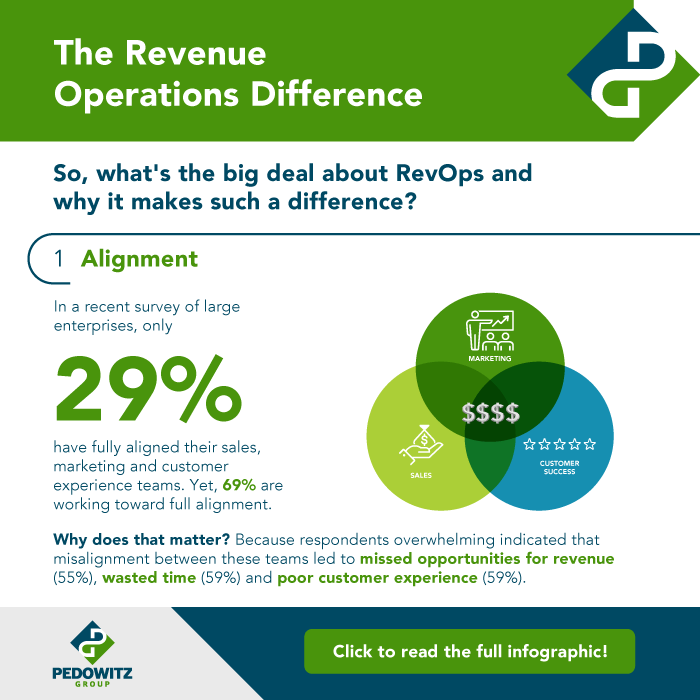
Click to jump to a section:
What Is It? | What It Is Not | A Comparison vs. Marketing Operations | Examining Core Functions | Organizational Structure
What is a Revenue Operations Function?
Revenue Operations (RevOps) delivers one view of the customer. At its simplest level, RevOps is the end-to-end business process of driving predictable revenue through a collaboration of marketing, sales, and customer success functions.
A successful Revenue Operations team establishes one view of the customer and delivers visibility across the entire revenue team, improve efficiency across the revenue process, drive revenue predictability, and achieve revenue growth.
Like a marketing operations function, when folks initially hear the term revenue operations, efficiency tends to be driving factor assumed as the best outcome for a revenue operations team. While efficiency is important, it is the central view of the customer that drives repeatable, predictable, and scalable revenue. You are creating the digital revenue engine.
Note how we define RevOps as a multi-functional organization. This is fundamental to defining RevOps team. This is not a collaboration. This is a team structure. It is a center of excellence.
Collaboration is the easy path, but it’s not true alignment. You cannot have RevOps team members reporting to different leaders. RevOps requires structural change with a single leader. We’ll talk more about structural change later in this blog.
If this sounds like something you’d like, here’s our obligatory note that our revenue operations consulting drives the changes you’ll need to make.
But … knowing what it isn’t won’t prevent you from falling into some common traps:
What Revenue Operations is Not
Because RevOps is a buzzword, you’re probably going to see multiple iterations of teams across the B2B industry. Here are some scenarios we have seen that we believe are NOT true RevOps teams:
Sales operations, rebranded as revenue operations.
If your RevOps team is sales-function-centric, it’s not a true RevOps team. Silos still exist between Sales, Marketing, and Customer Success. You will not have one true view of the customer.
Sales enablement is also not revenue operations, nor is it a part of revenue operations. The folks over at ShowPad said it best – sales operations handles the logistics of team organization to drive plans forward, and sales enablement uses those logistics to put plans into action.
Don’t confuse the two!
Sales and marketing announce they are aligned.
Unfortunately, saying you are aligned and being in alignment are two very different things. We’re in 2022, and the lack of sales and marketing alignment we continue to see is stunning.
But sales and marketing alone cannot drive revenue.
Companies that are passionate about diving revenue through customer relationships are realizing they must reorganize all operational functions that interact with the customer. This typically includes sales, marketing, and customer success, but it can also include support and partner channels as well.
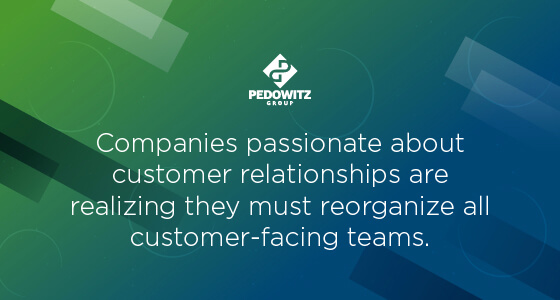
The Business Case for Revenue Operations
Now that we have a better handle on what a Revenue Operations team is and is not, let’s look at what the impact this team can have on an organization. The good news is that Revenue Operations done right has shown to provide outstanding results for organizations who invest in this function.
Let’s look at some statistics from trusted sources:
- 19% faster revenue growth (Forrester, 2019)
- 100% to 200% increases in digital marketing ROI (Boston Consulting Group, 2020)
- 10% to 20% increases in sales productivity (Boston Consulting Group, 2020)
- Avoid losing 20-30% of their revenue to operational inefficiencies (IDC, 2016)
- 10% increases in lead acceptance (Boston Consulting Group, 2020)
- 15% to 20% increases in internal customer satisfaction (Boston Consulting Group, 2020)
- 15% higher profitability (Forrester, 2019)
- Centralizing GTMs and creating agile operating models have a domino effect which can achieve a 20%+ ROI in sales (McKinsey, 2020)
Qualitative Viewpoints
Statistics are always a great start, but here are additional real-world quotes from revenue operations leaders as to why they have this critical function:
One source of data truth
When marketing, sales and customer success are three different functions, it’s easy to have different sets of reports and numbers for similar KPIs. With a centralized RevOps function, that friction goes away:
“Whatever data is presented is going to be a single set of data. So, if you’re presenting a number, you’re not going to have two different groups pulling two different reports and getting two different sets of data. The consistency and the accuracy is great.”
Kira Mondrus-Moyal, Senior Vice President of Global Marketing, Tricentis
Neutral and Objective data / reports
We’ve all been there. We present a set of reports or an analysis that makes our team look like rock stars…only to find out during the meeting, that these numbers are easily proven false by another operations team.
Everyone has their view of the data to sway the numbers to their favor.
“I don’t have a dog in this fight. I’m running this independent. I don’t care if marketing is right or if sales is right. I’m running this with a hat of doing the best for the company that I can, and it doesn’t matter where I report.”
Ruben Varela, Vice President Business Systems, Veracode
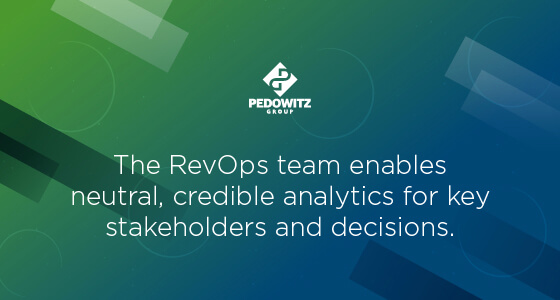
This adds an additional level of credibility and objectivity to analysis. The RevOps team basically becomes the “Switzerland” of data and analytics. Nothing is skewed, all data is aligned, all definitions are aligned. As Kira Mondrus-Moyal told us:
“The thing I loved the most is, there was an extra level of credibility. And what I mean by that is that when I would get up and present numbers, and if anybody had a question, I had this centralized operations function to back up the data that really had no skin in the game.”
Your centralized team can create one view of the customer.
There are so many technologies available today that promise the ability to see, understand, follow and engage your customer. So much so, the average number of technologies per organization is 137 and organizations are churning through 30% of those applications year over year (Blissfully, 2020).
All for that single view of the customer.
With a RevOps team, you can reduce tech bloat and focus on things that matter – like revenue growth.
“As long as the different customer facing parts of a company have different goals, you will not be able to create a cohesive customer experience. One of the biggest benefits in combining the operations functions is to be able to have an eye on both sides of the business and to create unity. Ultimately, this pays off for the customer and for the business.”
Alex D. Simoes, VP of Revenue Operations, Cut+Dry
While the benefits and performance improvements are impressive, it’s still an emerging concept that many organizations are trying to wrap their head around. In fact, most don’t have RevOps:
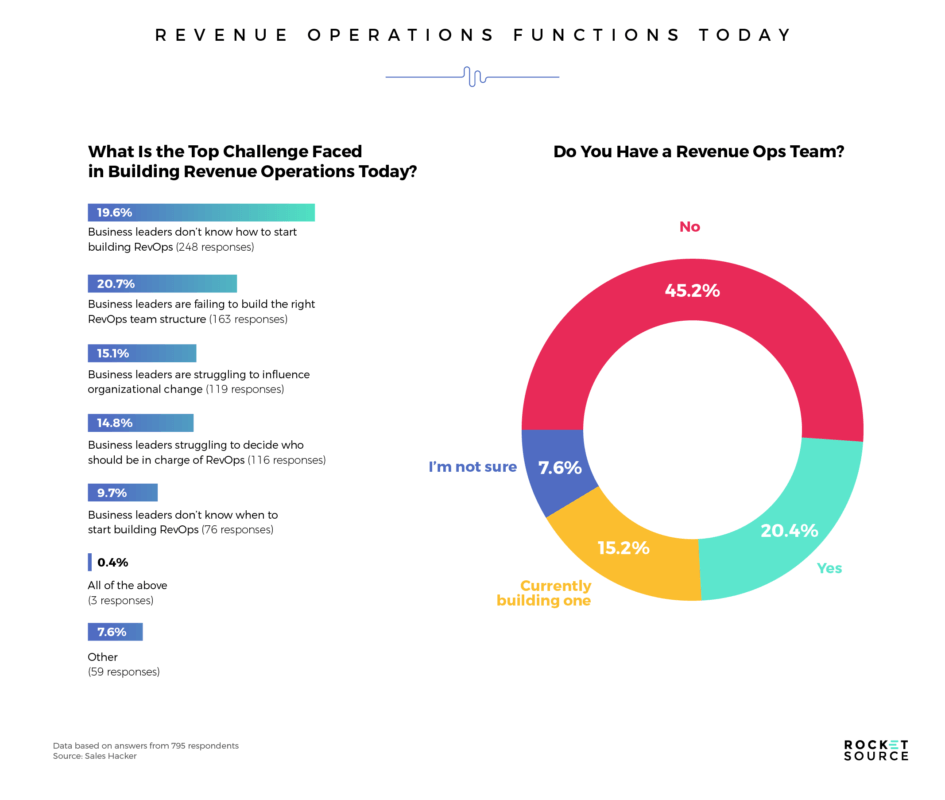
MOPs vs RevOps
Many of our readers may be familiar with the concept of marketing operations, but how does it relate to revenue operations?
The simplest explanation is this:
- Marketing operations is a function-specific view of how marketing can drive revenue
- RevOps is a multi-functional, company holistic view of how revenue can best be driven.
While it might be tempting to skip straight to a RevOps org structure, check to make sure your marketing operations function is as strong as other functions coming into the center of excellence. Avoid losing the marketing operations voice in comparison to sales operations and customer success operations, which may be more established in your organization.
Revenue today is a TEAM sport and marketing is a player. RevOps orchestrates that team, the plays, and the analysis of the outcomes.
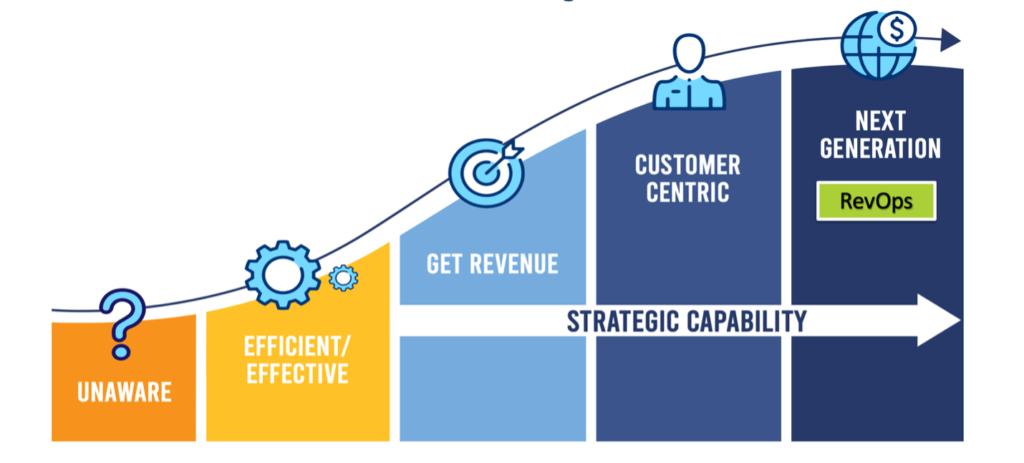
There is a logical maturity path from marketing operations to revenue operations. Marketing operations needs to be strategic to successfully join the RevOps team. A non-strategic marketing operations team is not strong enough to support multi-functional revenue growth.
Let’s review the differences between these types of teams:
The mission of a Regular Marketing Operations group is to improve the efficiency and effectiveness of marketing through people, process, technology, and data so that marketing can achieve operational goals. This type of marketing operations organization is typically more reactive in terms of strategy creation but serves a core function for marketing.
In contrast, the mission for a Strategic Marketing Operations group is to improve the efficiency and effectiveness of marketing through people, process, technology, and data so that marketing can achieve strategic goals including driving revenue and growth, enabling digital transformation, and leading customer centricity.
Finally, Revenue Operations is a segment of Strategic Marketing Operations that combines sales, marketing, and customer success operations into a single team and across the full customer life cycle. The purpose is to drive growth through operational efficiency and keep all teams accountable to revenue.
This holistic approach is designed to break down silos between departments and creates one line of sight to the customer.
Related: No matter what, your teams need the right tech. Get it with our martech consulting.
The Functions of a Revenue Operations Team
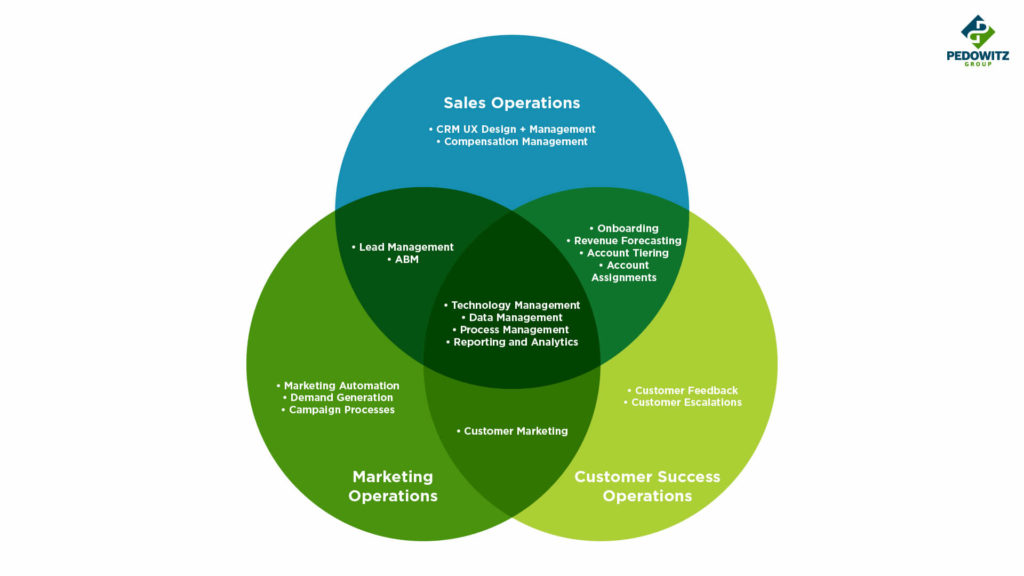
When we examine the three main teams that create a RevOps team, we see overlap in their roles and responsibilities. One of the benefits of a RevOps team is the removal of duplications. Most operations teams are responsible for the following:
- Technology management
- Data management
- Training and education
- Process management
- Reporting and analytics
In fact, those are the specific functions we outline for marketing operations. Similarly, you will see the same functions in sales operations with some differentiation.
Sales Operations
- CRM UX design, deployment, and management. In addition to management, the sales operations team heavily focuses on the ease of use of the tool in terms of permissions, page views, design, UI etc. to make it as easy as possible for sellers to leverage the system.
- Training and education as they pertain to onboarding new hires to processes. I want to state here that this does not include Sales Enablement. Sales Enablement is a different branch that goes beyond the scope of sales operations, they coach and develop sellers to meet company selling standards.
- Compensation management is probably the largest difference between sales and marketing operations. Sales operations is not just responsible for their own proof of compensation as a team, but responsible for the entire sales force – quota administration, goal setting, forecasting, commission calculations. This puts a lot of power in the hands of sales operations and that power is not something easily relinquished to another team.
Customer Success Operations
Customer success operations (CS Ops) shares many of the same functions as sales and marketing operations. Your usual suspects of an operations team apply here – tech administration, vendor, data and process management, reporting/analytics and training.
Here are some functions that are unique:
- CS Ops teams collect and analyze customer feedback. Whether it’s from a call center or customer success engagements, your CS Ops team will be gathering real-time feedback from your customers. This data helps to identify at-risk customers as well as identify customer pains and challenges that can be operationalized by sales and marketing.
- Training customer facing CSMs. Like sales operations, the CS Ops team has an entire workforce of customer facing personnel. Training includes keeping up to date on documentation processes, customer escalation paths and adhering to optimized workflows for better customer experiences.
- Forecasting cross-sell and upsell opportunities. The CS Ops team is uniquely positioned to gather the right data for customer retention. They are laser focused on expanding the lifetime customer value to your firm. Gathering this type of data helps customer success managers understand which customers have opportunity for expansion.
While each function has their own set of unique tasks and activities, we do see plenty of overlap.
Sales and marketing operations jointly own lead management processing.
Marketing and customer success operations both craft messages and engage with customers digitally.
Sales and customer success operations share account hierarchy, assignment and forecasting responsibilities.
Related: Five ways RevOps impacts your business
Organizational Structure Maturity Path
Creating a revenue operations team will cause high amounts of disruption to your business. Most organizations don’t jump directly into a centralized revenue operations team for a few reasons:
- Centralizing operations pulls away power from the individual functions
- The scope of aligning technology, data and processes feels like a climb up Mount Everest.
- Individual functions are not ready to collaborate
- Lack of executive advocacy (not just buy-in!) slows down the change process.
- The scope of aligning technology, data and processes feels like a climb up Mount Everest.
In a report from Lean Data in 2019, only 17% of RevOps functions are centralized. The vast majority are not centralized or quasi-formalized:
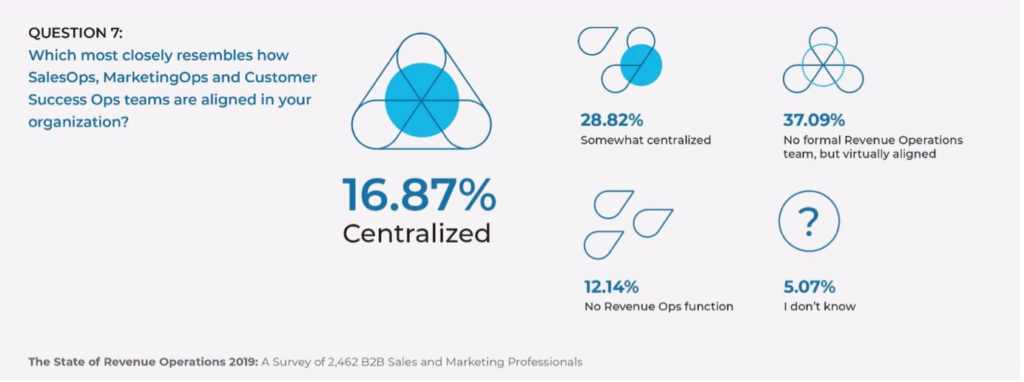
A stepped approach to developing a revenue operations team allows for the cultural, political, and technical challenges to be solves overtime.
Here is a real-world example of a financial services organization’s progression from good to better to best in terms of revenue operations business impact.
Good:
Our initial organizational structure establishes sales and marketing functions under a CRO with a dotted line to a RevOps Center of Excellence.
What this allows the organization to do is to centralize data-driven decision making and technology management, while not introducing so much disruption that it stalls adoption. It’s also the most cost-effective as there is not as many positions to fill or initiatives to start at the same time.
At the same time, the slow roll also means slower time to value and minimal impact on customer experience and revenue.
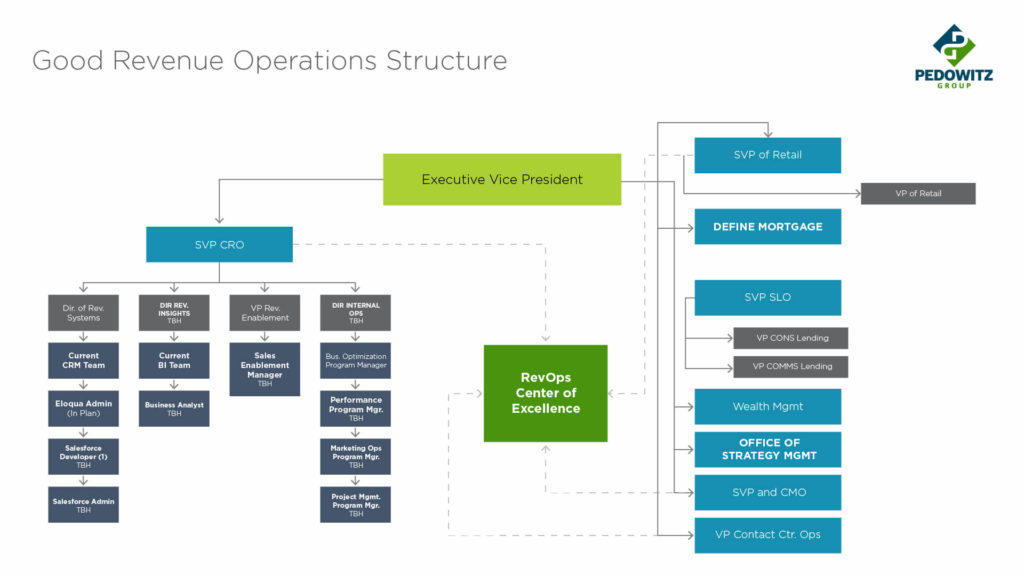
Better:
The difference in the “better” organizational structure focuses on folding in customer success operations as opposed to just sales and marketing organizations. Now, we have all three key functions centralized, with still a dotted line to a RevOps center of excellence. We still see some operational siloes, but the time to value will faster. Change disruption is higher and so is the investment.
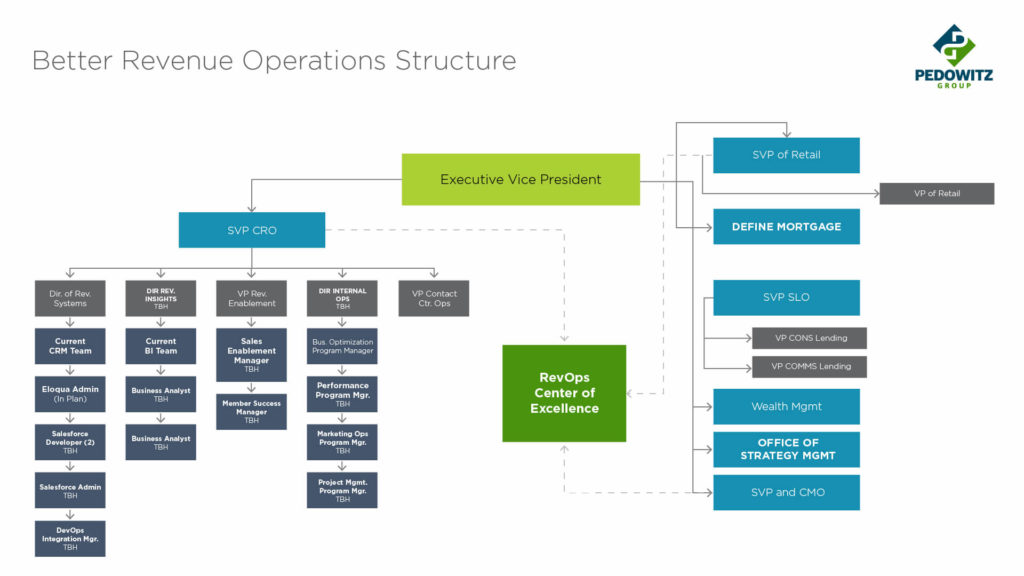
Best
Finally, we see the optimal structure. In this structure we have removed the Revenue Operations COE and moved all customer-facing operations to a central function. We will see higher time to value with optimal customer experiences supported by seamless integrated operations. High fives all around, you’ve climbed the mountain to the peak!
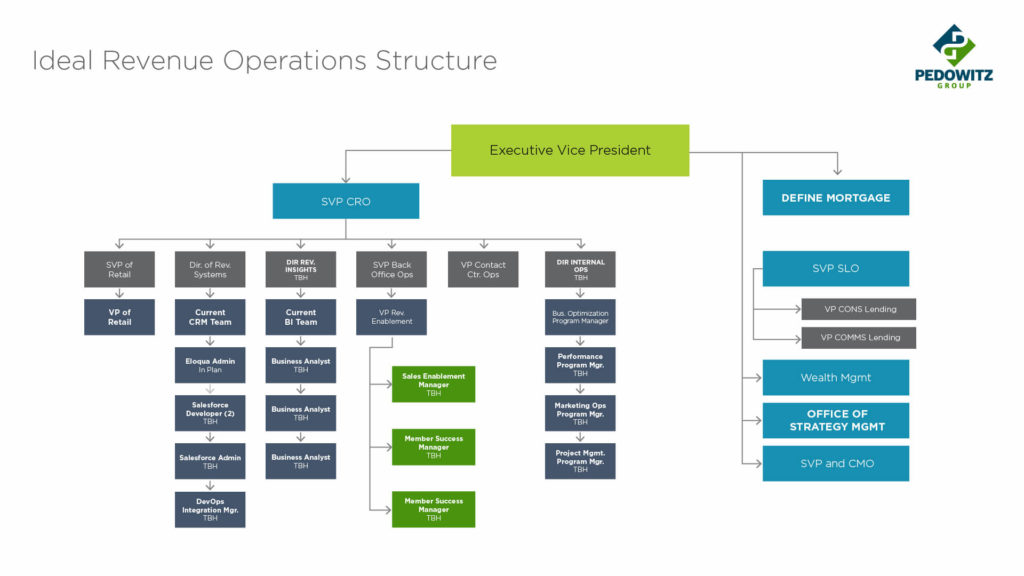
The Bottom Line: Revenue Operations Is A Journey
Revenue Operations, like Revenue Marketing, is a journey. The result yields dividends in return on investment, but the road to structural collaboration isn’t for the faint of heart.
Marketing cannot lead this initiative.
There needs to be a joint effort across sales, marketing and customer success lead by an executive who is proactivity advocating for the function, rather than passively approving.
Are you moving towards this model in your own organization?
If not, you may be leaving opportunity on the table.
Want to talk through this? We can help!

